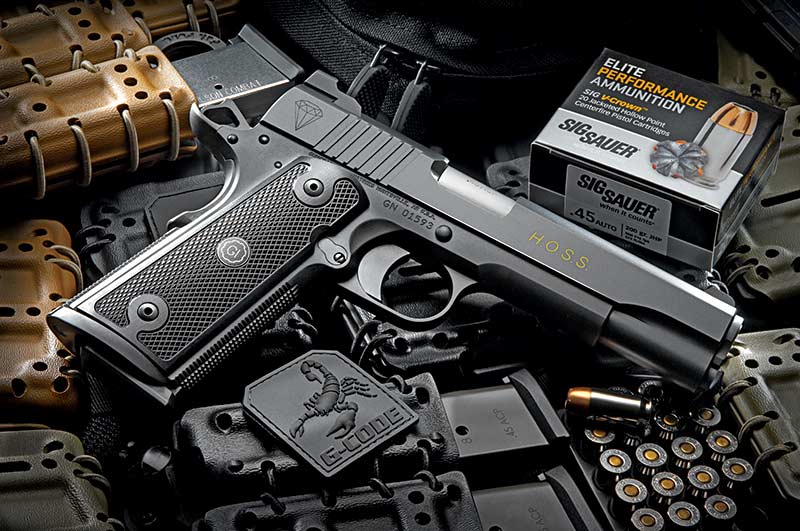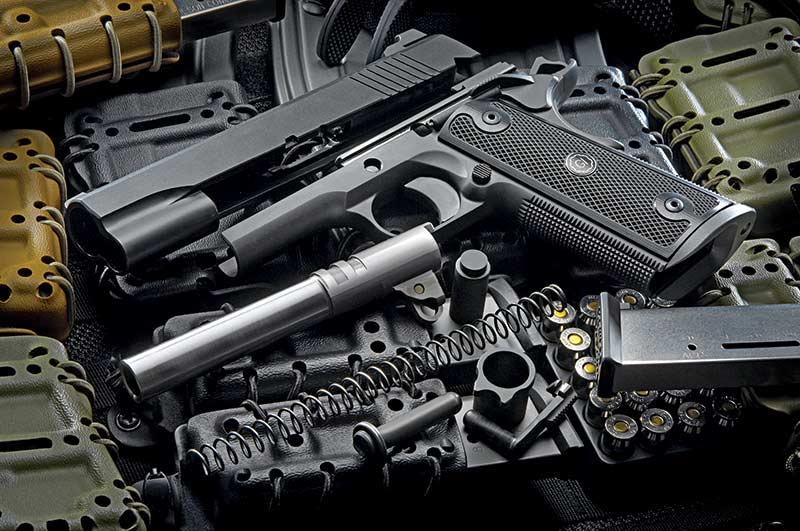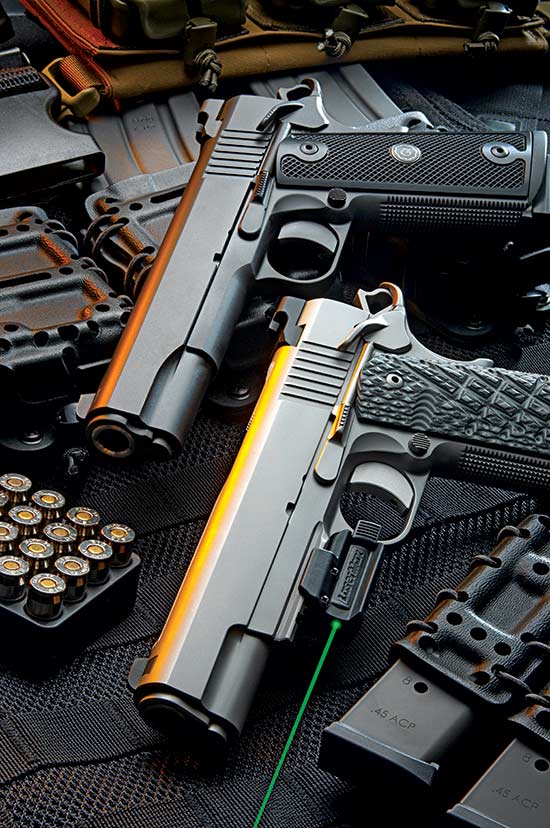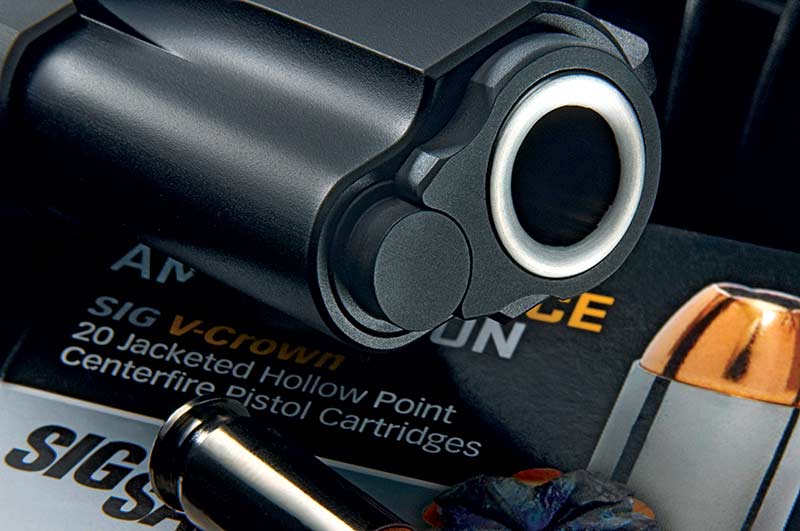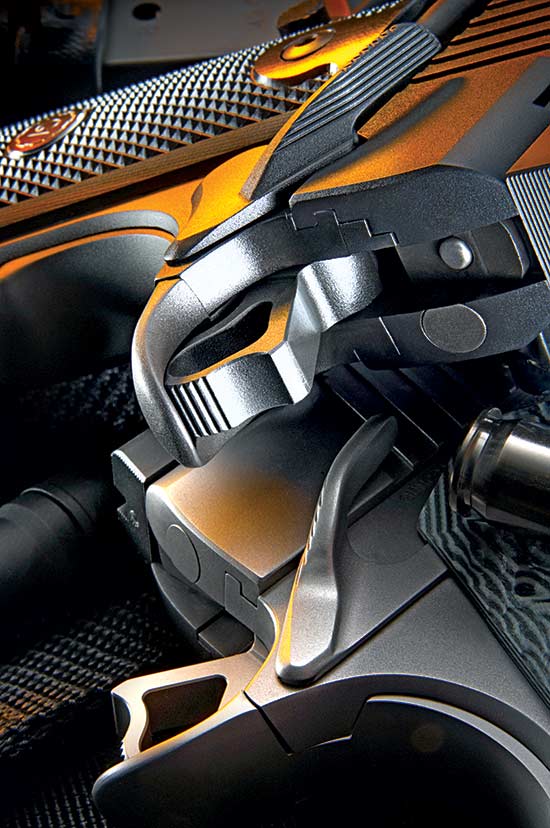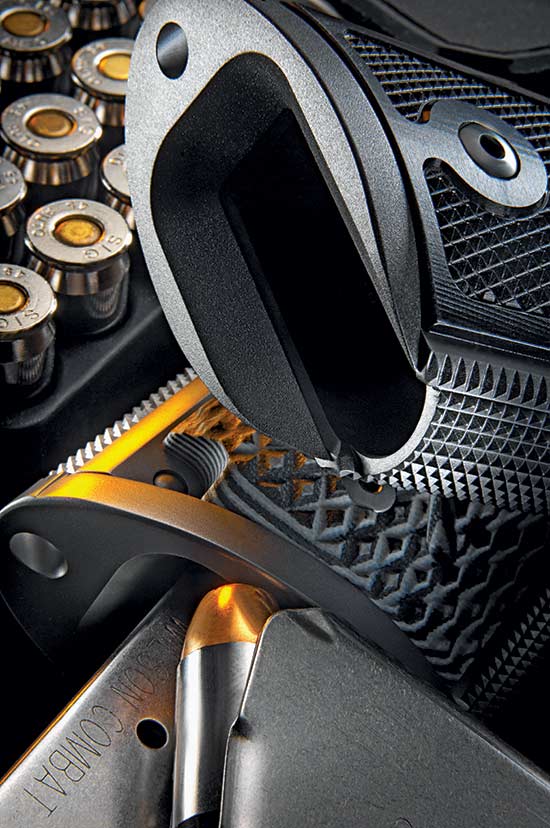Guncrafter's Hoss
The 1911 — Brawnier And More Reliable Than Ever Before!
We toss terms like “bulletproof” or “indestructible” around sometimes when we’re noting features and benefits in a product, especially guns. And while we don’t usually believe a product is actually bulletproof or indestructible, those terms and others like them convey a vivid mental image of Viking hammers, battleships and massive blocks of granite. None of which happen to make up a gun — but you get the point nonetheless.
In our present case, a bit of history is in order. And no, we won’t belabor the founding of the 1911 dynasty, but will remind ourselves the basic 1911 design is chasing 105 years these days. And while the car you or I drive resembles a 1911 Model T in the sense it has four wheels and an engine, the differences between the two technologies are at levels Henry Ford never even dreamed of. Ever.
The 1911
But we can’t exactly say that about a 1911, can we? If Mr. Browning picked up a modern 1911 he’d know exactly what he had in his hand. Would be able to take it apart, operate it and, in all honesty, likely improve upon it even now. Henry would likely not even be able to start a modern car. So where does that put us?
In two places, actually. One is being blessed with something so nearly perfect in its original form it’s only been enhanced and improved over the years, while the solid, basic form and design remains the same. There’s a quote that says something along the lines of “… you know when something is perfect when you can’t take a single thing away from the design.”
A sharp knife comes to mind. Take the edge away — a single thing — and you no longer have a knife, just a bar of steel. Add engraving or a fancy hilt and you still only have a knife. But take the basic, core idea away and the tool disappears regardless of how pretty it has become.
The second place we’re at is having to deal with 105-year-old technology and design. A hammer is a hammer, but improvements in hammer making allow modern framers to work faster, more easily and more efficiently. But a modern hammer still has a face for striking and still works the same way it did 1,000 years ago.
A modern 1911 still shoots a powerful .45 ACP cartridge, for instance, but we can now construct guns faster, more easily and more efficiently and end up with a better product. But have we significantly changed the methodology or truly addressed any significant areas of potential problems in the design? How far apart is today’s 1911 from those of 105 years ago? Would an extractor made today fit a 1911 made 80 years ago? Likely. Would they compare to the auto analogy? I don’t think so. To me, it’s almost like today’s 1911 designs might equate to a 1950’s car model. Or a 1940’s model?
Harsh words? Not at all — but honest words, yes. Today’s 1911’s are elegant, stylish and, in most cases, can keep up with anything recently invented. If this is so then, what did Guncrafter do to lift the bar high enough to get our attention?
The Concept
“First of all, the 1911 pistol in its standard configuration is a tough firearm,” said Alex Zimmerman in a note to me. Alex is the founder and head design guru at Guncrafter Industries. “It has stood the test of time and is still the handgun against which all others are measured.”
“That said,” he continued, “even the 1911 pistol can be improved upon. Being a 1911 user, gunsmith and engineer, my universe has revolved around Browning’s masterpiece for more than 35 years. I have a vast pool of experience to draw from when it comes to making meaningful improvement to the 1911.”
When Alex was visiting with me at my home when I first saw the HOSS model, I pushed him to explain what changes he made — and why. And to be specific.
“I applied three principles when choosing which parts to improve,” he said. “I identified the parts under the most stress and/or are the most likely to fail. Our team then decided which ways those same parts could be made stronger, more reliable and simply better. It was also important the improved parts were made to look and operate like standard 1911 parts and not affect the weight or function of the pistol.”
Ultimately, Alex and his team narrowed their attention to seven parts of the basic 1911 platform. The extractor, slide stop, plunger tube, ejector, barrel link, barrel bushing and the barrel came under close scrutiny. Each was examined, the job it did carefully analyzed, the engineering behind it studied, how it could be improved debated — and why it should or should not be changed was deliberated at length.
What Alex was looking for was something more than just a “biggie-sized” gun. It’d be easy to simply make a “120 percent” sized gun, but you’d end up with a club. Keeping the new bits inside of where the old bits fit was the challenge, while changing them enough to truly make a difference in strength.
“I’ll just go ahead and say it,” said Alex, “but I think this is arguably the first substantial improvement made to the 1911 since, well … 1911!”
So … how’d they do it?
Extractor
Extractors fail by either shearing off the hook (which clamps onto the rim of the case) or they simply lose their tension due to fatigue. A standard extractor is usually .150″ wide, according to Alex, while their new one in the HOSS is .200″ — a 33 percent increase. This makes it stiffer allowing it to flex less and still apply the right pressure on the case head. Since it’s basically a leaf spring, allowing it to flex less also equates to a longer, more reliable life.
This bigger size also allows more meat on the “hook” portion gripping the rim. A standard-sized extractor engages the case rim with just a small portion of the lower corner of the hook. All of these changes improve function and reliability in the long run.
Slide Stop
If you’re familiar with how a 1911 runs, the cross-pin of the slide stop essentially takes the full brunt of the barrel unlocking and the full impact of the slide closing. It has to manage the energy of a 3/4 pound slide running at break-neck speed, all in a few thousandths of a second. Some stock slide stops do shear under this stress. I’ve had it happen to me when shooting factory new guns, three times in the past 20 years.
A standard slide stop cross-pin is 0.200″. Guncrafter’s HOSS version is 0.250″ (a full quarter of an inch) — increasing the diameter 33 percent. According to Alex, “Engineering principles tell us when you increase the diameter by 33 percent you increase the strength by 77 percent. In this case, increasing it to a full 0.250″ makes it, in all honesty, unbreakable under normal use.”
Plunger Tube
This one surprised me as I’ve never really had any issues with plunger tube problems, although I have heard of them coming loose, or denting deeply enough to cause the plunger spring assembly to malfunction. This can trap the safety in the “safe” or “fire” positions, or even somewhere in between. A standard plunger tube is secured with two posts and is fairly thin-walled. During my own experiences with building 1911’s from scratch, staking and securing the plunger tube did show me the inherent weakness in this structure.
Alex told me, “We thickened the wall significantly to resist deformation from being dropped or clamped in a vise, for instance, and ours is secured with four posts, not the stock two. When installed by Guncrafter in our HOSS it will never come loose and the odds of being deformed greatly reduced. I give all credit to master gunsmith Ned Christiansen for this improved plunger tube. A great idea!”
Ejector
The ejector gets rid of the trash once you fire the round. If the empty case doesn’t come out, things grind to a halt. Bad things happen to ejectors all the time, from coming loose to actually shearing off. That’s an unfortunate thing since it’s “An instant showstopper!” as Alex says. Now the only thing left is to have a gunsmith drill out the sheared pin, hopefully without messing up your frame. What to do about it?
“Easy,” said Alex. “We increased the diameter of the post to twice the size of a standard post. Done deal.”
Barrel Link
If you’ve ever watched a slow-motion video of a 1911 under recoil, you can see it’s not the silky smooth play of part-against-part you may have in your mind’s eye. Unlike a ballet of lightly touching bits, it’s more of a crashing collision of heavy bits of steel, thrashing against each other and the shooter, driving the slide one way, the barrel in other directions, while empty brass collides against the ejector, missing the ejection port by micro-seconds as — hopefully — the returning slide scoops another loaded round from the magazine, chambering it and locking closed. All of this is held together by the swinging barrel link and slide stop cross-pin. Bang, slam, crash, slam again, jerk, pull … slam … then over and over again.
Most link failures happen due to faulty installation, with gunsmiths — and even factories — often installing the incorrect length of link, or from wear and tear of thousands of rounds being fired. Think about it: A short link will not allow complete lock-up of the barrel into the slide and cause high recoil battery and wear to all the bits.
A link which is too long will “jam” the barrel up tight, essentially “springing” it against the slide locking cut-outs, keeping things under extreme tension. When the round is fired, it slams open harder than needed and may not pull the barrel down completely causing more wear and tear. Repeat times 5,000 and you will see failures. Broken links, peening, battering and even broken barrel legs. Ouch. Another reason to make sure any 1911 is built correctly, especially custom models assembled by a gunsmith.
Guncrafter increased the width of the link by 22 percent, using a much stronger steel than normally used. Also, fitting this overbuilt Mac Truck-style link means it armors yet another dangerous wear area and helps to contribute to long-life and reliable functioning.
The Barrel
While standard 1911 barrels have proven themselves fine in the vast majority of cases, there are still blow-ups now and again, mostly due to defective ammo at one level or another. Alex felt building extra-protection into the barrel made perfect sense.
According to Alex, “We increased the chamber and barrel wall thickness by a whopping 56 percent. This barrel is massive, giving a shooter an unprecedented safety margin should something go amiss.”
Keeping the “stronger is better” theme going, Guncrafter engineered improved lower lugs (the “feet”) on the barrel. This is where the link attaches. After many thousands of rounds, in some cases, these feet have been known to shear off on some barrels. While it may be traced to defects in the original manufacturing of the barrel, ill-fitting links, etc., nonetheless, it can happen.
“We beefed up the feet to greatly reduce the possibility of failure,” Alex explained to me. “In conjunction with the stronger slide-stop and barrel link, this high-stress area has been fortified to a remarkable degree.”
Indeed it has. Take a moment to compare the standard components with the HOSS system as shown in one of Chuck Pittman’s remarkable photos here and you’ll easily see the differences.
The Bushing Too
And why not? As Alex outlined, “We needed a bigger bushing to work with the beefier barrel so we took the opportunity to build up the strength of the bushing as well.”
According to Alex, the bushing gets a lot of its strength from the flange, which also helps to prevent flexing and shifting. A standard 1911 bushing flange is about 0.090″ thick. Guncrafter’s new HOSS bushing is 0.140″ thick — a 56 percent increase. The thicker flange adds strength, offering protection to the muzzle area. I think the increased thickness adds a certain muscular look too, almost daring you to try to break something.
Does It Work?
Yes, indeed. Being familiar with the standard guns of Guncrafter, I ran the HOSS (and the accompanying American model in our photos), firing several hundred rounds, mostly through the HOSS. There were no surprises. I’ll admit, yet again, the sheer pleasure of shooting well-built firearms. Experiencing their accuracy, reliability and good looks more than makes up for the temporary pain of their original cost — long forgotten as time passes and your enjoyment continues.
The American (a railed 1911 with “conventional” parts) performed reliably and effortlessly and was a pleasure to shoot, as are all of Guncrafter’s models. As a custom pistol of around the $3,000 mark (but being custom that number can vary), it easily delivers accurate, smooth performance and would be excellent for home defense, duty use, competition and just plain personal enjoyment. Accuracy was in the 1″ to 1.5″ at 25 yards window, with the excellent trigger a compelling reason for its ability to deliver consistently.
The HOSS, while meeting the same performance envelope regarding accuracy, was clearly a beast. While essentially the same as any 1911 in basic design and function, the beefier components belie their presence with a “chunkier” feel. It’s subtle, and someone not extremely well versed in how a 1911 runs would likely not even notice. But there is a certain solidarity, a slight muzzle-heavy feel — it seems — and a “heavy steel doors closing” sense as the slide runs home, the gun fires, cycles and closes home again.
It’s a 454 cubic-inch V-8 compared to a 350. Both have adequate power, both are reliable, both have proven history — but the 454 has more presence, a lower rumble, a heavier footprint at some level. It loafs along while the other seems to work a bit harder to keep up. It’s subtle, but it is — nonetheless.
To continue the analogy, when asked what engine is in your collector muscle car, if you say, “A big block, 454 …” people usually nod, as if that’s the final answer — often muttering a soft “wow” under their breath.
That’s what you have with the HOSS.
Okay, So?
The military has what they call “Mean Time Between Failures” or MTBF. It’s an accepted norm for parts breakages or failures of one sort or another. The key term being “accepted” failures. I think Alex and his team wanted to get as close to “no accepted failures” as possible.
“Any chain is only as strong as its weakest link. In the case of the HOSS, we’ve upgraded the potential weakest links and they are all much stronger,” said Alex. “In a standard 1911 there may be parts failures after x-number of rounds in their normal MTBF cycles. I feel strongly we’ve decreased the likelihood of any failure exponentially in the HOSS. In fact, I think, with normal use — it may never happen.”
Strong words, indeed, and while only time will tell, I’m leaning hard on the side of what Alex says. Will the average shooter be able to wear out their standard configuration 1911 — especially a high quality, well-fitted example — in their lifetime? I doubt it very much. There may be need of periodic replacement of some of the components Alex talks about, but overall, the vast majority of recreational shooters will never have significant wear issues with a 1911.
But — what if you are a competitor, or a peace officer, or soldier or someone who absolutely, positively has to have 100 percent reliability out of your 1911? What if you are among those whose livelihood or perhaps their very lives rely on a 1911? Would you not try to stack the deck in your favor? Take every advantage you can? Cheat, as it were, to make sure you had fate on your side?
Of course you would. It’s precisely why Guncrafter created the HOSS.
This remarkable 1911 will be very, very difficult to return to Alex’s shop.
For more info: https://www.guncrafterindustries.com

